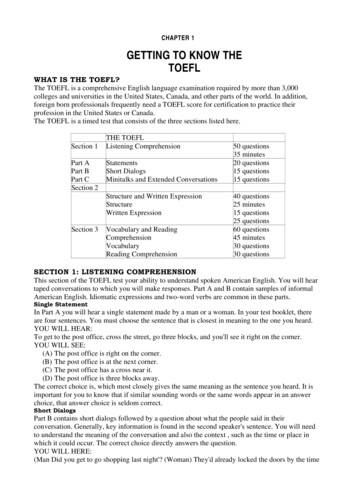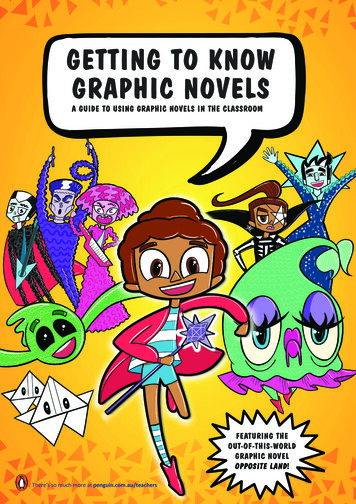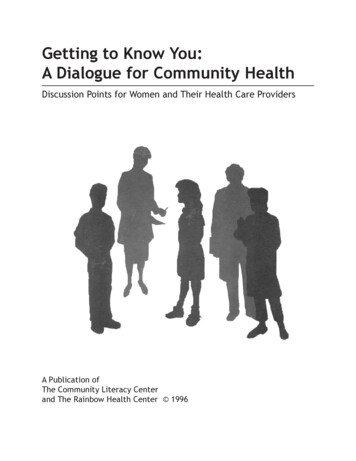
Transcription
CHAPTER 1GETTING TO KNOW THETOEFLWHAT IS THE TOEFL?The TOEFL is a comprehensive English language examination required by more than 3,000colleges and universities in the United States, Canada, and other parts of the world. In addition,foreign born professionals frequently need a TOEFL score for certification to practice theirprofession in the United States or Canada.The TOEFL is a timed test that consists of the three sections listed here.Section 1Part APart BPart CSection 2THE TOEFLListening ComprehensionStatementsShort DialogsMinitalks and Extended ConversationsStructure and Written ExpressionStructureWritten ExpressionSection 3Vocabulary and ReadingComprehensionVocabularyReading Comprehension50 questions35 minutes20 questions15 questions15 questions40 questions25 minutes15 questions25 questions60 questions45 minutes30 questions30 questionsSECTION 1: LISTENING COMPREHENSIONThis section of the TOEFL test your ability to understand spoken American English. You will heartaped conversations to which you will make responses. Part A and B contain samples of informalAmerican English. Idiomatic expressions and two-word verbs are common in these parts.Single StatementIn Part A you will hear a single statement made by a man or a woman. In your test booklet, thereare four sentences. You must choose the sentence that is closest in meaning to the one you heard.YOU WILL HEAR:To get to the post office, cross the street, go three blocks, and you'll see it right on the corner.YOU WILL SEE:(A) The post office is right on the corner.(B) The post office is at the next corner.(C) The post office has a cross near it.(D) The post office is three blocks away.The correct choice is, which most closely gives the same meaning as the sentence you heard. It isimportant for you to know that if similar sounding words or the same words appear in an answerchoice, that answer choice is seldom correct.Short DialogsPart B contains short dialogs followed by a question about what the people said in theirconversation. Generally, key information is found in the second speaker's sentence. You will needto understand the meaning of the conversation and also the context , such as the time or place inwhich it could occur. The correct choice directly answers the question.YOU WILL HERE:(Man Did you get to go shopping last night'? (Woman) They'd already locked the doors by the time
I got there.(Man) What does the woman mean?YOU WILL SEE:(A) She arrived in time to shop.(B) She was too late.(C) She locked the doors.(D) She had to buy the door.The correct choice is. Since the doors were locked when she arrived, she could not have goneshopping. Note that the other choices use words heard in the conversation. Choices that containsuch words are usually not correct.Extended Conversation / MinitalksIn Part C you will hear an extended conversation or a minitalk. The English in this section isgenerally more formal and academic, typical of English conversation or lectures that take place in auniversity or college setting. After each conversation or minitalk, there are between four and eightspoken questions about its content. Choose your answer from among the four choices that appear inyour test book-let. Look at the example here.YOU WILL HERE:Man: Good morning, ladies and gentlemen. Welcome to this tour of one of the nation's mostimportant cities, Chicago. Before we begin, I'd like to give you some background information thatwill make the tour more enjoyable for you. The city was founded in 1837. Its strategic location onLake Michigan quickly made it the center of commerce for the Midwest section of the country. It iscurrently the third largest metropolitan area In the United States. The city's site is generally level,built mostly on glacial plain. The narrow Chicago River extends one mile inland from LakeMichigan, where it splits, dividing the city into North, West, and South sides. Chicago's weather issubject to rapid changes, but generally the climate is cold and windy in the winter, and hot andhumid in the summer.Woman: What gave Chicago an advantage over other Midwest cities?YOU WILL SEE:(A) Its level site.(B) Its location on Lake Michigan.(C) Its large population.(D) Its location along the Chicago River.According to the minitalk, would be the correct choice. Remember that you will not have a writtencopy of the speaker's talk or conversation and you will only hear it once. You must concentrate ondetails, such as names, dates, and the main idea of the selection that you hear. Do not read thechoices as you listen to the talk. Listen care-fully and try to remember what you hear.SECTION 2: STRUCTURE AND WRITTEN EXPRESSIONThis section contains two types of questions, both designed to test your ability to recognize correctstyle and grammar in written English. The sentences are academic; ones that you typically find incollege level texts, journals, and encyclopedias. The sentence topics include the social sciences,physical and life sciences, and the humanities.StructureThe structure questions test your ability to recognize correct structure and word order. Thesequestions consist of a sentence with one or more words missing. You must make the choice thatbest completes the sentence. Here is an example of this type of question.YOU WILL SEE:a short time after the Civil War, Atlanta has become the principal center oftransportation, commerce, and finance in the southeastern United States.(A) While rebuilt(B) It was rebuilt(C) Rebuilt(D) When rebuilt
The correct choice is (C). The other choices make the sentence incorrect or awkward.Written ExpressionThe written expression questions test your ability to recognize errors in grammar or expression.These questions consist of complete sentences with four underlined words or phrases. You mustidentify the underlined part of the sentence that needs to be changed in order to make the sentencecorrect. An example follows.YOU WILL SEE:The Navajo Indians have displayed a marked abilityABto incorporate aspects of other cultures into a changing,Cflexibility lifestyleDThe correct choice is (D). Flexibility, a noun, appears where an adjective must appear. In addition toinappropriate parts of speech, be sure to check for missing words and extra words that areinappropriate for the context.SECTION 3: VOCABULARY AND READING COMPREHENSIONGood reading skills and an ample vocabulary are keys to doing well on all sections of the TOEFL.This section of the TOEFL specifically test these skills. Many TOEFL test takers complain that theydo not have enough time to carefully answer all questions in this section. It is very important thatyou follow the instructions in this book so that you will use all the allotted time to your advantage.VocabularyThe first questions on this section will test your English vocabulary. There are 30 academicsentences, each containing an underlined word. You must choose the word that has the samemeaning from among the four choices. Here's an example.YOU WILL SEE:The United States has instituted a set of forest conservation measures to maintain forest land.(A) accepted(B) published(C) established(D) suggestedThe word that is closest in meaning to the tested word, instituted, is choice (C). Further hints forvocabulary questions can be found in Chapter 2.Reading ComprehensionYour ability to read and understand college level reading material is test on this part of the TOEFL.You will find five or six reading passages, each followed by four to seven questions. You mustwork quickly and efficiently. Here is a sample passage.YOU WILL SEE:A lens has one or more curved surfaces that refract or bend, light rays passing through it to form animage on a surface beyond the lens. Examples of such surfaces are the retina of the eye or a moviescreen. The distance from the lens to the focal plane is known as focal length. In cameras,telescopes, and similar devices, the lens is turned on a screw-thread mounting to adjust the focallength. This action allows focusing of images of objects at various distances. In the human eye,focal length is adjusted by muscles that alter the lens curvature. Light rays of different colors arebent by varying degrees as they pass through a curved surface. This causes a distortion of theimage, known as chromatic aberration. In cameras, sharp images are obtained by arranging two ormore lenses so that the aberration of one cancels out the aberration of another. Such an arrangementof lenses is called an achromatic lens.QUESTION:According to the passage, what is focal length?(A) A curved surface that refracts light.(B) The distance from the focal plane to the lens.
(C) Adjustment by the muscles that alters lens curvature.(D) The degree that light rays of different colors are bent by the lens.This is a factual question. The information needed to answer this question is directly stated in thetext. Choice (B) is the correct answer. Some questions will ask you to draw conclusions based onmaterial in the passage, other will ask about the main idea of a selection. Some may even ask whatinformation does not appear in the passage.THE TEST OF WRITTEN ENGLISHMost TOEFL test sessions now require the Test of Written English. The TWE will test your abilityto respond to topics that you may find on typical college level writing assignments. It will test yourability toexpress yourself as well as your organizational skills . The score on this test is reported separatelyand is not used to determine your TOEFL score.SOME HELPFUL HINTSOn all parts of the TOEFL, be sure to answer every question. If you must guess, choose choice (B)or (C) since they are slightly more likely to be the correct choice than (A) or (D).Watch your time! Be sure to wear a watch and be aware of the time you have remaining in eachsection. Do not waste time reading directions or example in your test booklet. You should becomefamiliar with these before you take the test. When you are told to begin, go directly to the firstquestion. When time has expired on a section, you may not return to it. Work quickly andaccurately. If it seems obvious that you will not finish a section within the time limit, guess orchoose answer (B) or (C) in order to complete the section.Prepare yourself for the test. In addition to this book, Barron's How to Prepare for the TOEFLprovides you with practical hints, tapes with sample questions, model test, and a grammar review tohelp you maximize your TOEFL score.
CHAPTER 2UNDERSTANDINGTHE TOEFL:Vocabulary and ReadingComprehension SectionDeveloping a good English vocabulary is the most important way to prepare for thevocabulary you will see on the TOEFL. In addition to developing a good English vocabulary, it isvery important to know the kind of vocabulary you will see on the TOEFL and to understand how itis tested.Vocabulary and Reading Comprehension make up Section 3 of the TOEFL. This sectioncontains 30 vocabulary questions and 30 reading comprehension questions. Remember that yourgeneral vocabulary is tested in all sections of the TOEFL. However, it is in this section of theTOEFL where your knowledge of specific vocabulary is tested.You will have 45 minutes to complete this section of the TOEFL. Many test takers report thatthey do not have enough time to complete the reading comprehension questions, so you shouldwork quickly in order to complete the vocabulary questions as soon as you can. If you follow thestrategies in this book you will have more time to complete the Reading Comprehension section ofthe TOEFL.The Vocabulary QuestionVocabulary questions are written in a formal, academic style, typical of most college oruniversity level texts and journals. The topics of these sentences are those that a first-year collegestudent in North America would be likely to encounter. The topics come from such areas as thenatural sciences, business, liberal arts, and the social sciences. Many sentences contain references toNorth American places and personalities. Others will refer to historical events and may includedates. It is important for you to understand that your knowledge of these areas is never tested on theTOEFL. You do not have to be familiar with the content of the sentences to be successful on thissection of the TOEFL.Each TOEFL vocabulary question consists of a single sentence followed by four choices.These choices are marked by letters (A), (B), (C), (D). Most sentences have one word underlined,and less frequently, some sentences may have a phrase underlined. You must identify the wordamong the choices that has the same or similar meaning as the under-lined word or phrase in thequestion. These words are called synonyms. Let's examine a sample question.Many organisms change their role in habitats from one season to another(A)diet(B)size(C)color(D)functionThis question is typical of the Vocabulary section. The topic is from the natural sciences andthe sentence contains a single underlined word. The correct answer is (D) function. Function is asynonym for role. As in this example, the word you select is the one that best matches the meaningof the underlined word. Note that all four of the choices make sense in the sentence. Vocabularyquestions are written so that the con-text of the sentence seldom helps you to determine the meaningof the word. Therefore, you must understand the vocabulary to select the correct choiceStrategiesRemember that your reading comprehension skills are not tested on this section of the test.Therefore you should not waste time reading the sentences. Simply look at the underlined word andchoose its synonym from among the four choices. This strategy will save you time and prevent
frustration.You must choose the word that maintains the original meaning of the sentence. Be preparedfor unfamiliar vocabulary presented in unfamiliar contexts, but do not waste time reading thesentences to determine the word's meaning. You will need this time for the Reading Comprehensionsection. If you do not know the word tested or can't deter
vocabulary you will see on the TOEFL. In addition to developing a good English vocabulary, it is very important to know the kind of vocabulary you will see on the TOEFL and to understand how it is tested. Vocabulary and Reading Comprehension make up Section 3 of the TOEFL. This section contains 30 vocabulary questions and 30 reading comprehension questions. Remember that your general .











